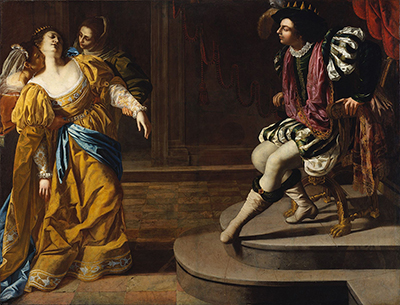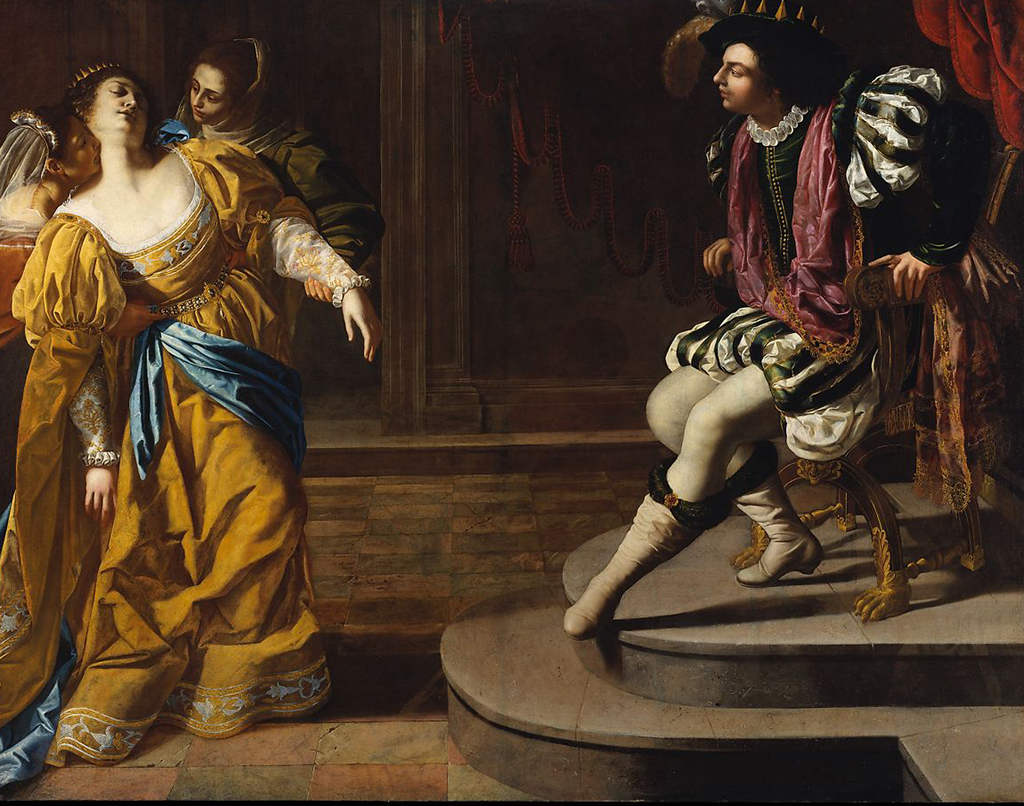Esther before Ahasuerus is an oil on canvas artwork completed between the late 1620 and 1630. It has a dimension of about 208.3 cm. The painting Esther before Ahasuerus shows a biblical heroine Esther, walking to the king to plead with him to spare her people. This was after King Ahasuerus ordered the execution of all Jews in the Persian Empire.
The work captured the exact moment when Esther was fainting before the king. From the paint, she is depicted to look more like an ordinary woman than idealized women she really was, and the king is painted to appear comical than how kings are usually depicted. The style of dressing and the setting of the paint appear very contemporary. Esther is seen to be better illuminated than the king who is in shadows. She is seen in a more glamorous, elegant, and refined dress. Artemisia uses her as the main protagonist and the scene gives her more attention. The colors in the paint are mute and not vibrant. The background is in red shades, darkened with brown as shadows. The harmonious use of the red and brown color extends to the king who is also in a red outfit. However, the yellow dress that Esther is in, makes her stand out, and becomes the focal point of the paint.
Angles have been perfectly used to mark how the stage is and also reflect the use of the Baroque style era. Esther and the King are in parallel diagonal angles, as the king is leaning forward while Esther is fainting backward. Among her greatest influencers was her Tuscan father, Orazio Gentileschi who was also a painter. Because her father's painting style was Caravaggio-esque, she was therefore heavily influenced into the style as depicted in most of her paints. Another figure that had a great impact on her art work was her private tutor, Agostino Tassi. An exhibition dedicated to her work is to be held at the National Gallery in London. She also influenced her daughter, Prudentia, into painting although nothing much about her paintings is known. Artemisia was, no doubt, hoping that her offspring could continue the struggle for women in the art world and extend her own artistic legacy into future generations. As it turned out, her daughter was unable to do this, but her own legacy was so strong that it persisted through art history, allowing us to continue to learn about and appreciate her work even all these centuries later.
The overall piece measures well over two metres in width and height, making it one of the artist's largest canvases. The content of this painting refers to Esther standing before her husband, Ahasuerus who was the King of Persia. She requests that he reverses a decision that would mean the persecution of many people from her own Jewish background, and she takes a huge risk in standing up for these people. Thankfully, the King responded well to her plea and decided to repeal this ruling, when actually he would have been within his rights to actually punish his wife for supposedly challenging his authority in public. Courage and justice are therefore the themes which spread throughout this artwork and the role of a strong women within a male dominated society would often appeal to this arist when looking for inspiration for her work. You will see similar with her series of works around Judith Slaying Holofernes (Naples), where two women work together to outwit and murder the far stronger and high ranking male figure, leaving him brutally butchered in an unflattering death.
The precise moment of this painting features the queen collapsing, having fasted for several days in protest at the ruling of the king's chief advisor. Her clothing and jewellery is styled in a way that makes her both elegant and beautiful, but also to signify to the viewer of her status as queen. Her own crown is identifiable, for example, in the very far top left of the painting. Two women stand behind her to give her support, perhaps pointing to the bond and friendship between female friends and how that can provide great strength. The King also looks ready to come to her rescue too, underlining his devotion to his wife and concern for her wellbeing - we see his left leg outstretched, as if about to catch her in his arms as he faints. Research into this impressive artwork has suggested that she initially started it whilst living in Venice, before then completing it upon her arrival in the southern city of Naples. She moved around several times in her life and was able to construct a healthy list of patrons who respected her work and also desired to see more of a feminine touch within Italian art.
There have been several novels that were influenced by Artemisia including The Dinner Party by Judy Chicago, The Heidi by Wendy Wasserstein which covered her paint Judith Beheading Holofernes, Life Without Instruction which was commissioned by Nightwood Theatre, also the film Artemisia by Agnes Merlet tells the life history of Artemisias entrance into a professional artist, and The Passion of Artemisia a novel by Susan Vreeland among many other. Other works by Artemisia are The Virgin nursing the child between 1616 and 1618, Annunciation in 1630, Bathsheba done between 1645 and 1650 and St Cecilia Playing a Lute in 1616. She has become known as a true feminist icon in recent years because of the success of her career within a male-dominated industry and society, as well as the awful assault that she experienced but was still able to overcome the trauma of that incident. She was also very rare in achieving success within the Renaissance and Baroque eras, with most other famous female artists having appeared in the centuries that followed afterwards, at which point opportunities were more readily available.
This painting from 1628-1630 can now be found at the Metropolitan Museum of Art, USA. It remains one of the few artworks from her career to be located in collections outside of Europe and her small oeuvre means that this is unlikely to change in the coming generations. Indeed, the value of her paintings her risen enormously but few owners would be willing to part with their possessions because of her critical significance within the path of art history. Some of the exciting artworks that can be discovered within this important American institution include the likes of Crucifixion and Last Judgement diptych by Jan van Eyck, The Fortune Teller by Georges de la Tour, Polyptych with the Nativity by Rogier van der Weyden, Portrait of Juan de Pareja by Diego Velazquez and also Opening of the Fifth Seal by El Greco. Besides those, there is so much more to see, with art and antiquities from all manner of different civilisations to enjoy within a colossal collection which can rival anything in the world.





